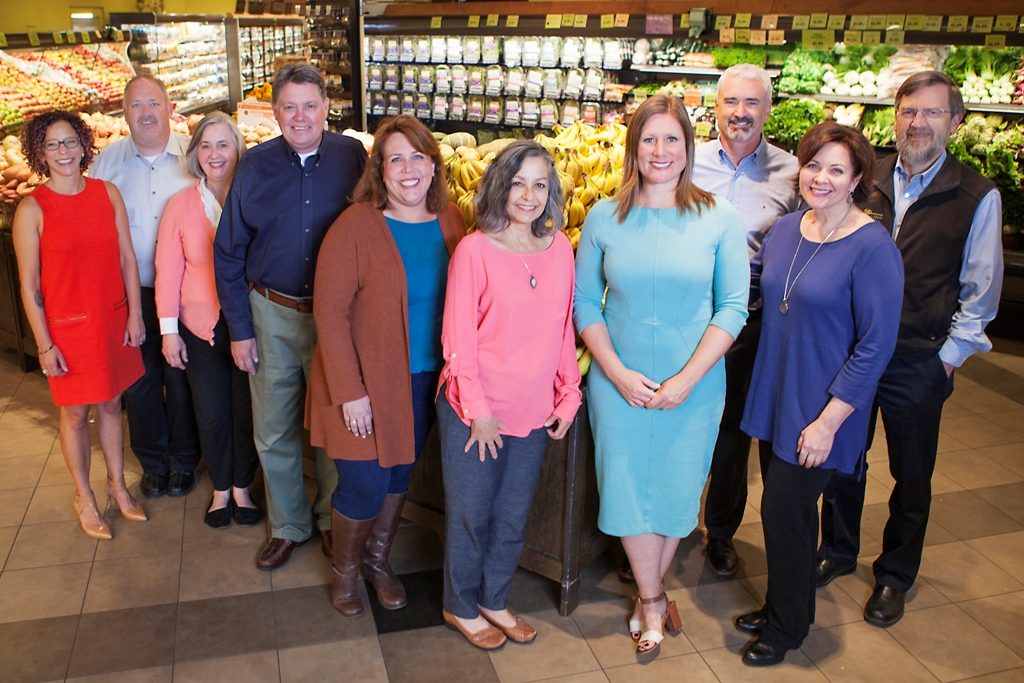Pioneer SpiritLike most successful businesses, PCC has slowly evolved into what it is today. The alchemy that creates this success is complex, but what has driven PCC all these years is what CEO Cate Hardy calls “the ethos of the people here.”
“Here” is the Pacific Northwest, specifically the Puget Sound region of Washington State. “This is the part of the country that’s known for its pioneering spirit,” says Hardy. “And as we have found our roots here, we’ve really grown with a pioneering community and as a pioneering part of the food industry.”
An example of this pioneer spirit is exemplified by the way PCC members responded to the open comment period in 1997, when the U.S. Department of Agriculture (USDA) released its proposed organic standards. This was very early on in the lifecycle of national organic regulations—perhaps before most U.S. consumers had any awareness of this important issue. Not so for PCC members, however. “Those standards would have included genetically engineered ingredients, irradiated ingredients and an allowance for sewage flush on farms,” explains Trudy Bialic, director of public affairs. “The pushback from our membership was so enormous that a full 30,000 comments came from PCC members.” That is 10% of the total 300,000 comments submitted to USDA.

Washington had its own organic standards before national standards were established and because of this culture, PCC became instrumental in advocating for organic produce and establishing a marketplace for organic milk and eggs. “There was beginning to be an awareness around food ahead of the rest of the country,” says Bialic. “We were looking at what was happening on the national landscape and trying to figure out how we could operate sustainably in that framework, locally.”
Of course, as Randy Lee, chief financial officer for PCC points out, selling natural foods wasn’t always as complex as it is now. “It’s gotten much more sophisticated,” he explains. “In the early 1970s, it was about putting food on the shelves like brown rice, eating somewhat healthier. Organic was a concept but not defined, and there was much more ambiguity about what healthy eating was.”
Now, that market has certainly expanded and PCC continues to lead the way in holding their inventory to a high standard. But, let’s start at the beginning.
Growth of PCCPCC Natural Markets started out in Seattle, WA, in 1953 as a food buying club with 15 participating families. The intention was to reduce the cost of food by combining their buying power. As their membership grew, the May Valley Food Club became a consumer cooperative called Puget Consumers Cooperative, otherwise PCC. It would not be until 1967 that PCC opened its first storefront, prior to that operating out of members’ homes.
1969, when PCC moved its storefront to the Seattle’s University District, marked a shift in priority from saving money to providing natural and wholesome food to its members. Adopting these new values around food was an important step forward for PCC, but just as important was acknowledging that in order to succeed, PCC had to function and grow like a business.
When Lee came on the scene in 1970 as an assistant manager, PCC was struggling financially. “There was a lot of recovery that needed to happen in the early 1970s, but there was also a different perspective...of being something a little different and growing,” explains Lee. “We began placing a bit more emphasis on economics and becoming a bigger economic engine rather than another neighborhood mom-and-pop store.” Having seen how large supermarkets put local mom-and-pop shops out of business, PCC understood that remaining very small was not economically viable.

“So PCC took the perspective that growth was okay, but that was not a common viewpoint at that time among co-ops,” says Lee. One of the first tangible steps toward growth for PCC was when the Board approved the acquisition of another cooperative, which became its second store in 1978. All the while, PCC’s membership grew as did its reputation for having high standards for food, further aiding its growth. “It was a matter of being opportunistic, finding a place that made sense where we already had a lot of members,” explains Lee. “We were looking primarily in areas where we already had members and some brand recognition...that’s how it worked well.”
PCC’s pursuits as a business and its values as a consumer cooperative became inalienable from one another, what today Hardy describes as PCC’s triple bottom line of financial, social and environmental. This was proven in the late 1980s when PCC opened a fourth store in another neighborhood and attempted to sell conventional foods, assuming that the population in that area would prefer that. However, the local members were very disappointed by the selection and demanded the products PCC was expected to sell.
Eventually, PCC did right by its members and yanked the conventional food off the shelves. If PCC had to grow, it would not be at the expense of its principles. The triple bottom line means that one factor cannot be achieved without the other. Financial success is necessary to achieve PCC’s social and environmental mission, but if the co-op does not actively pursue its values, members and shoppers will not be satisfied. And keeping members happy is very important because PCC is consumer
One does not have to be a member to shop at PCC and the prices are the same for everyone, but membership allows customers and employees (who must also be members) to have active role and voice in the market. “Most days, I have a phone or e-mail exchange with a member and because they’re owners, they feel very appropriately entitled. We want them to feel entitled, to share with us what they think we’re doing well and what we need to improve,” says Hardy.“The reason you walk into the front door of PCC is that you don’t have to turn the product around and check the ingredients. We have prescreened every item…We hold everything that comes in the door to a very high bar.” —Cate Hardy, CEO
The way PCC effectively functions as both a cooperative and a business is through a system called Policy Governance. Members elect a Board of Trustees to represent their interests and the Board hires a CEO to manage the business, as well as hire and oversee staff. In essence, the CEO works for the members. Lee considers PCC’s adoption of Policy Governance to be a landmark event because it sorted out organizational inefficiencies by drawing “a distinction that was healthy for an organization like ours, the distinction between governance and management,” he says. The Board governs PCC’s policies and the CEO manages the business utilizing these policies.
It is important to note however, that PCC and its CEO must also consider the bigger picture. “My focus goes beyond members, including other shoppers as well,” says Hardy. “My management team and I take the holistic view...and just like any CEO, I want to have a happy staff. I want to have improving sales and net income. I want our social and environmental mission fulfilled. Like any CEO, I want the organization to continue to grow and thrive.” An important part of this is reaching out to new shoppers.

According to Hardy, Seattle is one of the fastest growing communities, growing at a rate of about 10,000 people per month, with residents relocating to the area from all over the country. That’s not only a great deal of potential shoppers but also a large area to cover. Therefore, under Hardy’s leadership, PCC has continued to grow, announcing plans for two new locations, as well as forging relationships with Instacart and Amazon PrimeNow to further their reach with online delivery. However, just as important as improving one’s reach and presence, is communicating one’s mission. These new transplants may not know PCC, what it stands for and how the cooperative model works. “When we opened our Issaquah coop store, which is now our largest store, there was a significant amount of confusion about whether you had to be a member to shop there,” says Hardy.
For this reason, Hardy sees an opportunity to better educate shoppers about PCC and its cooperative model. “We have a lot of great competitors up here. There are a lot of good people trying to do what we’re doing. We just simply have to find our voice, one that is clear and resonant and heard by people who are going to respond to what it is we do and they’re going to say, ‘Those are my people; that’s where I want to shop,’” explains Hardy.
Raising the BarThe relationship and open dialogue between members and store management is steeped in trust. Trust that what they are buying meets the qualities that they demand and trust that if they think something needs to be addressed, they’ll be listened to. “People who know us, know that the reason you walk into the front door of PCC is that you don’t have to turn the product around and check the ingredients,” says Hardy. “We have prescreened every item whether it’s in the produce department or the health and beauty care department or our in-house prepared foods in our kitchen. We hold everything that comes in the door to a very high bar.”
Since becoming health oriented in the early 1970s and then in 1977 establishing the Product Information Committee, which is now called the Quality Standards Committee, PCC has continued to update and improve its criteria for product selection as the food landscape changed and greater effort had to be made to ensure the desired quality. This brings us back to that pioneer spirit.
In the early 1990s, organic agriculture was about avoiding pesticides. Around that same time in the dairy industry, recombinant Bovine Growth Hormone (rBGH) was introduced and created a demand for hormone-free dairy. Being forward-thinking, PCC connected two Washington dairy farmers with Organic Valley, the dairy cooperative, and essentially created the market for organic milk in Washington State. PCC also created the organic egg market after commissioning a small farm in Eastern Washington to supply pasture-raised organic eggs for the co-op.
This is a common narrative for PCC. While most retailers work primarily with distributors, PCC has more than a dozen direct relationships with farmers, “some that we take everything they can make,” explains Darrell Vannoy, head of merchandising. “There are even some that we can specify which crop we would like them to grow because they need to rotate crops to maintain soil and we can direct them in the things we know we can sell or that we have a need for,” he continues.

Currently, 95% of PCC’s produce is organic and PCC demands that its meat and seafood be sustainably and responsibly sourced. PCC holds animal welfare to a high regard, meaning that all meat and poultry must be raised with outdoor access and their guidelines prohibit crates, cages, electric prods, byproducts in feed, cloning, sub-therapeutic antibiotics and added growth hormones. In 2006, PCC became the founding partner of the Monterey Bay Aquarium’s Seafood Watch Program, selling only seafood that has been fished or farmed in ways that protect sea life and habitats.
While PCC’s standards and prescreening of products provides shoppers ease of mind, PCC goes a step further by employing a color-coded label system on shelf tags, allowing shoppers to make informed purchasing decisions. These labels designate products as organic, non-GMO, gluten free and/or local. Over 60% of PCC’s labeled products will contain one of these attributes. It’s also important to note that PCC has made a commitment to become a non-GMO retailer, starting with the labeling of all genetically engineered foods by 2018.
This does not come without some sacrifice. In the produce section, seasonal items are not available at times and being a part of the Seafood Watch Program can limit the seafood you can sell. “It is hard for us to find enough organic produce to have a 95% organic produce department and it is hard to find non-GMO items in certain categories,” says Hardy. “But if you’re really trying to be in the natural foods business...you have to stay true to your core values, even if that means that you have to tell your customers: ‘we don’t have red bell peppers this time of year because we simply can’t get them.’

PCC shoppers may also find that a product they consistently buy is no longer stocked. Most recently, the market reevaluated its HABA section and updated its standards to reject over 500 ingredients that did not meet its requirements for safety, efficacy, sourcing and environmental sustainability. That’s a lot of ingredients that can put a decent dent in one’s inventory. But ultimately, PCC and its shoppers are better for it. “Generally, what we find is we all win when we make a change and improve our standards. It is what customers want and it’s part of building loyalty and trust; they feel like there is somebody looking out for them,” explains Bialic.
This can translate into better profits. In March of 2016, PCC removed a number of toothpastes from their shelves because the products contained sodium lauryl sulfate. The following month, PCC experienced a 5% surge in toothpaste sales.
Crucial to this is having good communication with shoppers. “We make sure our store staff is well educated and prepared for this,” says Bialic. “When they explain this to customers, they’re grateful.” It’s also important to have good communication with manufacturers because it’s not about removing inventory, it’s about improving inventory. An example of this is when PCC discovered that the caramel color in all products is artificial, but often labeled incorrectly as natural. They sent letters to all the vendors informing them that the caramel coloring is artificial, many of which did not know, and asking them to eliminate it from their products. As a result, manufacturers like Zevia actually reformulated its products to accommodate PCC.
“What our standards were five years ago, we have improved on greatly,” says Bialic. “It’s not a fixed document, it’s a living document that has to evolve.”
PCC will continue to be at the forefront of change, listening to its members and looking out for all its shoppers, so that customers can make confident and informed choices. That is why PCC is WholeFoods Magazine’s 2016 Retailer of the Year.WF
Published in WholeFoods Magazine July 2016








